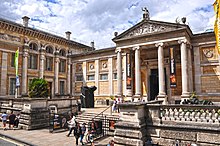May Hamilton Beattie
May Hamilton Beattie | |
|---|---|
| Born | 13 April 1908 |
| Died | February 1997 (aged 88) |
| Partner | Colin P. Beattie |
| Academic background | |
| Education | University of Edinburgh |
| Thesis | Studies in microbic dissociation and variation with special reference to the acid-fast and the diphtheroid bacilli (1932) |
| Academic work | |
| Discipline | Bacteriologist |
| Institutions | University of Edinburgh |
May Hamilton Beattie (13 April 1908 – February 1997) was a Scottish researcher dedicated to delving into the beauty of Oriental rugs, establishing it as a field of research at the University of Oxford.
Early life
[edit]Beattie was born in Edinburgh in 1908.[1] At the age of 21, she finished her Bachelor of Arts degree at the University of British Columbia.[1] In the following three years, Beattie undertook scientific research training and earned a Ph.D. degree from the University of Edinburgh.[1] In 1937, she quit pursuing her medical degree.[1]
Career
[edit]
Beattie nurtured her interest and started her collection of rugs and carpets when she lived in Baghdad with her husband, who taught Bacteriology and was a director of Pasteur Institute.[2] She examined and appreciated the materials and texture of rugs in scientific approaches with her related academic background.[1] To gather information on textile materials, she took her journey to various places worldwide for her research on every aspect of the carpet.[2] Moreover, Beattie worked with Charles Grant Ellis, the American Historian, to conduct further and thorough studies on the origin of rugs.[2]
Family
[edit]While Beattie gave up her medical degree, she married Dr. Colin P. Beattie, who was appointed Professor of Pasteur Institute.[2] They moved to Baghdad and lived for nine years until the evacuation to India during World War II, ultimately returning to England in 1946.[2]
Contributions
[edit]
Beattie wrote several articles and catalogues for the journal of rugs and several collections.[2] In 1976, she gathered her accomplishment at the Mappin Art Gallery in Sheffield, proclaiming her discovery of rugs in various designs.[2] Regarding the results of her study, which had been archived by the Ashmolean Museum.[2] Also, to bring up more scholars focusing on carpets and rugs, In 2000, the May Beattie fellow in Carpet Studies was built up at the Ashmolean Museum by May Beattie.[3]
Publication
[edit]- Recipes from Baghdad, edited by May H. Beattie (Indian Red Cross, 1946)
- Carpets of Central Persia, With Special Reference to Rugs of Kirman, edited by May H. Beattie (World of Islam Festival Pub. Co., 1976)
- The Thyssen-Bornemisza Collection of oriental rugs, edited by May H. Beattie (Villa Favorita, 1972)
References
[edit]- ^ a b c d e "May Beattie". HeraldScotland. Retrieved 2022-05-27.
- ^ a b c d e f g h Ashmolean Museum, University of Oxford. "Ashmolean − Eastern Art Online, Yousef Jameel Centre for Islamic and Asian Art". jameelcentre.ashmolean.org. Retrieved 2022-06-03.
- ^ "May Beattie Visiting Fellow in Carpet Studies | data.ox.ac.uk". data.ox.ac.uk. Retrieved 2022-06-03.
